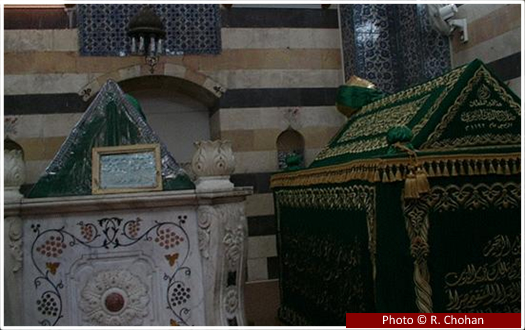
The green tomb on the right (refer to the picture above) houses the grave of Salahuddin Ayyubi, the Muslim general who fought the Crusaders at the Horns of Hattin in northern Palestine and recaptured Jerusalem for the Muslims on 2nd October 1187 CE. On the left is an empty marble sarcophagus donated by Emperor Wilhelm II of Germany to the mausoleum.
Salahuddin Ayyubi’s real name was Yusuf ibn Ayyub, the title of Salahuddin “The righteousness of the faith” was given to him as a result of his actions as a soldier fighting for Islam. He was born in Tikrit, in modern-day central Iraq, to Kurdish parents. Between 1187 and 1189 AD Salahuddin Ayyubi captured 50 Crusader castles and much of the Crusader kingdom. His actions as a kind and just ruler made even his enemies remember him as chivalrous and honourable. During the siege of the Kerak castle he refused to bombard a tower in which a honeymoon couple were staying.
Baha ad-Din, one of Salahuddin’s officials wrote, “…Everyone who appeared before him was treated with honour, even infidels . Once a Frank prisoner was brought before the Sultan. He took one look at Salahuddin and the prisoner became white with fear and terror and agitation was clearly visible on his face. The interpreter asked him: ‘What are you afraid of?’ the prisoner replied, ‘At first I was afraid of seeing that face, but after seeing it and standing in his presence, I am sure that I shall see only good in it.’ The Sultan was moved, pardoned him, and let him go free”
Salahuddin and Richard (the Lionheart) grew to respect one another as military leaders. When he heard that Richard had fallen ill in Ascalon, he sent peaches and pears to help restore him to health. He also sent packs of snow from Mount Hermann to cool the King’s fever. At Arsuf, when Richard lost his horse, Salahuddin sent him two replacements.
The Jewish philosopher Maimonides was one of Salahuddin Ayyubi’s personal physicians. When Jerusalem was recaptured, Salahuddin invited the Jews, who had been banished by the Crusaders, back to Jerusalem to live peacefully among the Muslims.
Salahuddin died of a fever on March 4, 1193, at Damascus, not long after Richard’s departure. Salahuddin had given most of his money away as charity. When they opened his treasury they found there was not enough money to pay for his funeral.
You can see Salahuddin Ayyubi’s tomb just outside the Ummayid Mosque in Old Town in Damascus, Syria.
(Information obtained from Islamic Landmarks’ website)



